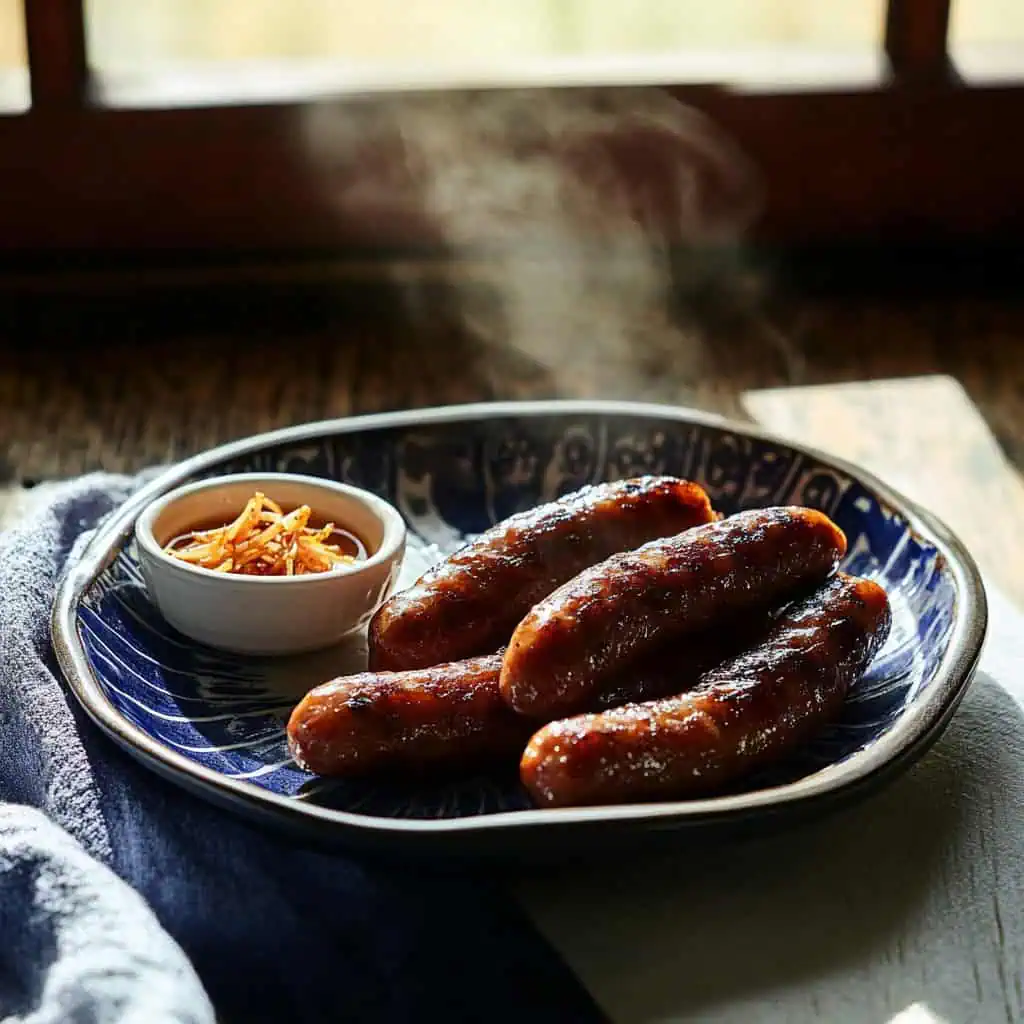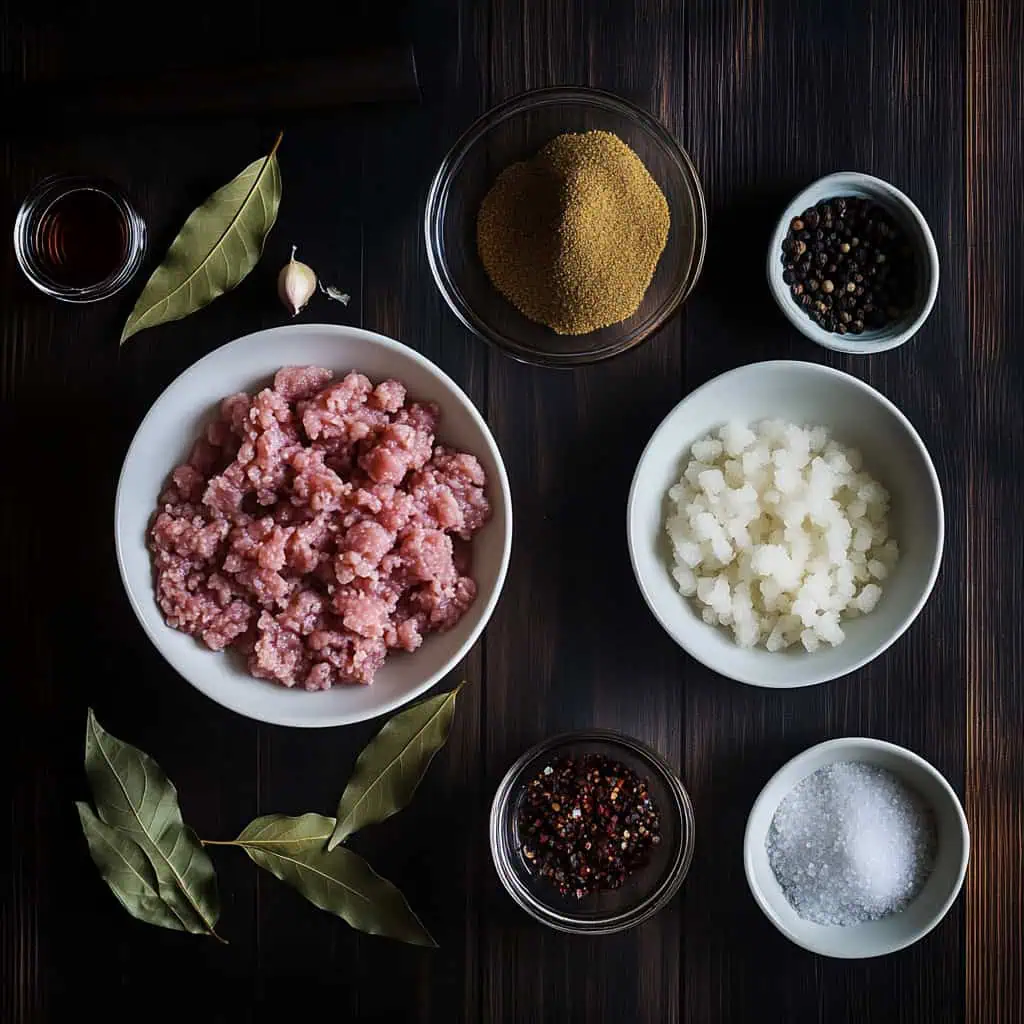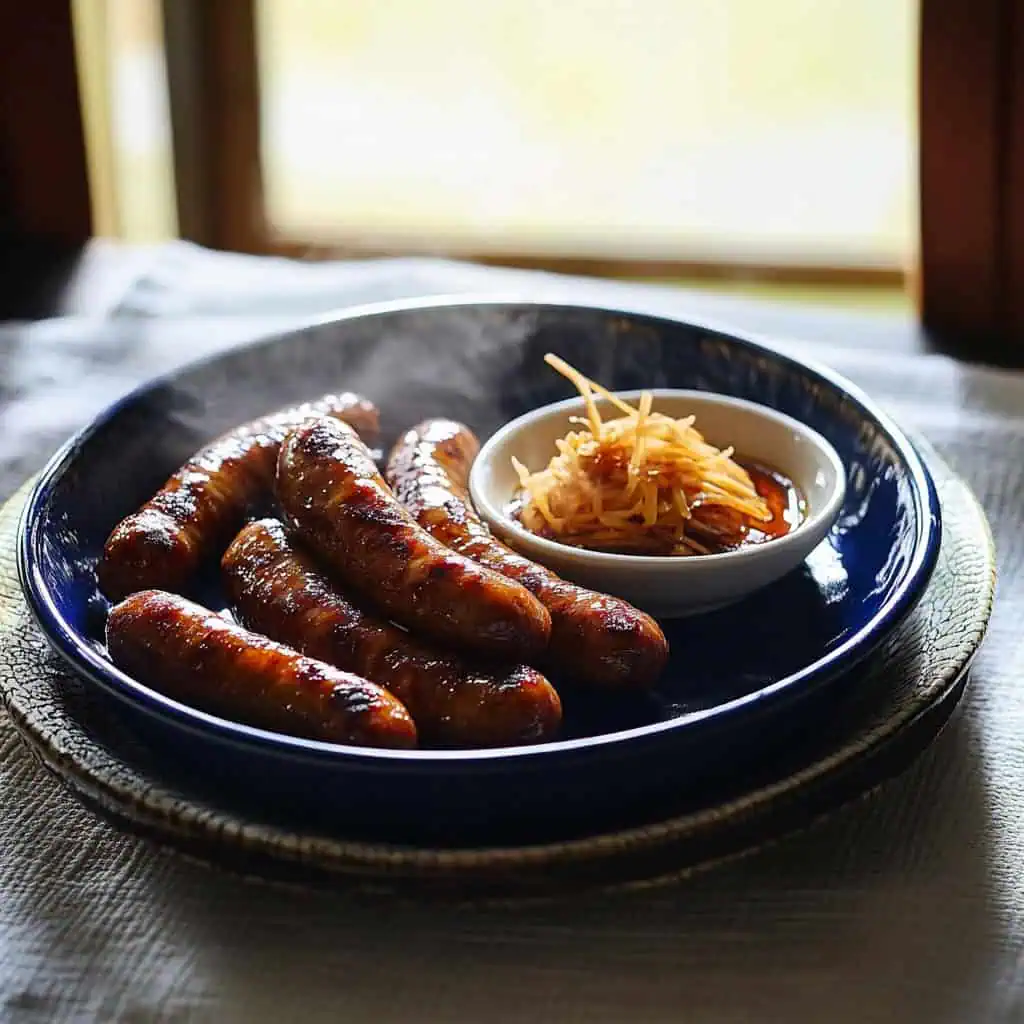Growing up in Bataan, just a stone's throw away from Pampanga (the culinary capital of the Philippines), I've always been spoiled with the most incredible longganisa.
While each region has its own special version, there's something about this homemade garlicky longganisa, with the mouthwatering aroma of sizzling sausages and sinangag filling the kitchen.
After years of perfecting this recipe, I'm excited to share my version that combines the best of both worlds: the garlicky punch of Pampanga-style longganisa with the slightly sweet notes that my family loves.
This recipe will help you create those perfectly caramelized, garlicky sausages that pair wonderfully with garlic rice and runny egg yolks. Trust me, once you master this homemade version, you'll never go back to store-bought longganisa again!
Jump to:

Why You'll Love This Recipe
- Authentic Flavor: Experience the true taste of Filipino breakfast sausage made from scratch
- Customizable: Adjust the sweetness and spiciness to your preference
- Make-Ahead: Perfect for batch cooking and meal prep
- Versatile: Can be made with or without casing
- Cost-Effective: More economical than store-bought versions
- No Preservatives: Control exactly what goes into your food
Ingredients
This recipe uses a carefully balanced mix of ingredients that create authentic Filipino longganisa. The pork provides a juicy base while generous garlic delivers that signature punch.
Brown sugar and soy sauce create the sweet-savory balance, while apple cider vinegar adds tanginess and helps preserve the meat naturally. Paprika gives color and mild flavor, with optional red pepper flakes for those who enjoy a hint of heat.
The 80:20 meat-to-fat ratio ensures the perfect texture, juicy but not greasy.

For the Sausage:
- 1 kg lean pork meat, minced
- ¼ kg pork fat, minced
- 2 heads garlic, crushed
- ⅓ teaspoon ground bay leaf or 1 leaf finely chopped
- 3 tablespoons brown sugar
- ¼ cup soy sauce
- ⅓ cup apple cider vinegar
- Salt to taste
- 2 teaspoons sweet paprika
- 1 teaspoon coarsely cracked black pepper
- 1 teaspoon red pepper flakes (optional)
For Casing Option:
- Sausage casing
Or For Skinless Option:
- 3 tablespoons cornstarch
Equipment
- Meat Grinder: For mincing pork if not using pre-ground meat. This ensures the ideal texture and allows you to control the coarseness of your grind.
- Mixing Bowls: For combining ingredients properly and allowing enough space to mix thoroughly.
- Sausage Stuffer (optional): Makes filling casings easier and more uniform if making traditional longganisa with casing.
- Kitchen Twine: For tying sausage links evenly and creating uniform portions.
- Heavy-Bottom Skillet: Provides even heat distribution for perfect caramelization without burning.
- Measuring Spoons & Cups: For precise measurements that ensure consistent flavor.
- Food-Safe Gloves: For handling meat hygienically and protecting hands from strong ingredients like garlic.
- Airtight Container: For proper curing and storage that keeps the longganisa fresh and preserves its flavors.

How To Make
- Start by mixing ground pork and pork fat in a large bowl. Add the crushed garlic, ground bay leaf, brown sugar, soy sauce, apple cider vinegar, salt, sweet paprika, black pepper, and red pepper flakes (if using). Mix everything well with clean hands until fully combined. Let this mixture rest for 1 hour at room temperature to allow flavors to start melding together.
- For regular longganisa with casing, prepare your sausage casings and fill them with the meat mixture - don't overfill or they might burst. Tie the casing with kitchen string every 4 inches to make individual sausage links. For skinless longganisa, simply mix 3 tablespoons of cornstarch into your meat mixture, then shape the meat into small logs about 3 inches long.
- Place your shaped sausages in a covered container and let them cure in the refrigerator for 2-5 days. This curing process is essential as it develops the flavors, improves texture, and helps preserve the meat naturally.
- When you're ready to cook, put your longganisa in a pan and add about ½ to 1 cup of water - just enough to cover the bottom of the pan. Cook over medium-low heat for about 10 minutes or until the water is gone. Poke holes in the sausages with a fork to help the fat render out properly.
- Keep cooking for another 3-5 minutes, stirring occasionally, until the longganisa turns reddish-brown and looks glossy. Add a tiny bit of oil if needed to help with browning and creating that desired caramelized exterior.
- Serve hot with garlic rice, fried eggs, and fresh tomato slices. Don't forget to put some spiced vinegar on the side for dipping - this traditional accompaniment cuts through the richness perfectly.
- If you have extra uncooked longganisa, you can keep them in the refrigerator for up to a week, or freeze them for up to three months. Just remember to thaw frozen longganisa in the refrigerator overnight before cooking.

Tips from Lola's Kitchen
- Garlic Quality Matters: Use freshly crushed garlic instead of pre-minced for an explosion of authentic flavor. The oils released from freshly crushed garlic create that distinct aroma that's essential to proper longganisa.
- Perfect Your Meat Ratio: The meat-to-fat ratio should be 80:20 for ideal texture. Too little fat results in dry sausages, while too much makes them greasy. This golden ratio creates juicy sausages that caramelize beautifully.
- Patient Curing: Don't rush the curing time - it develops complex flavors and improves preservation. Even one full day makes a difference, but 3-5 days creates truly exceptional longganisa with deeper flavor profiles.
- Low and Slow Cooking: Begin cooking with water and use medium-low heat for thorough cooking before caramelization. This traditional technique ensures the meat cooks through properly before the exterior caramelizes.
- Fork Technique: Pierce the sausages while cooking to release excess fat and prevent bursting. These small holes also allow flavors from your cooking liquid to penetrate the meat.
- Save the Gold: The rendered fat from cooking is liquid culinary gold! Save it for making the most authentic and flavorful garlic rice to accompany your longganisa.
- Rest Before Serving: Allow cooked longganisa to rest for 2-3 minutes before serving. This helps juices redistribute throughout the sausage for maximum flavor in every bite.
- Hand Mixing: Mix the meat mixture with your hands (wearing gloves) to feel the proper texture. You'll know it's ready when it feels slightly sticky and holds together well.
Substitutions
- Meat Alternative: Ground chicken or turkey can replace pork, but increase fat content (add 5-10% more) to maintain juiciness. Dark meat chicken works best for better flavor and moisture.
- Soy Sauce Alternative: Coconut aminos create a gluten-free option with a slightly sweeter profile that complements the garlic beautifully.
- Vinegar Options: White vinegar or cane vinegar (sukang maasim) can replace apple cider vinegar. Each brings a slightly different tang, with cane vinegar being most traditional.
- Sweetener Choices: Muscovado or palm sugar (panutsa) can replace brown sugar for more complex caramel notes and authentic Filipino flavor.
- Coloring Alternative: Annatto powder (atsuete) can replace paprika for an authentic Filipino color and subtle earthy flavor.
- Binder Options: Tapioca starch or rice flour can replace cornstarch for the skinless version if needed.
Troubleshooting
- Too Dry Sausages: Add a bit more fat to the mixture or reduce cooking time. For already-mixed batches, incorporate 1-2 tablespoons of cooking oil into the mixture.
- Too Wet Mixture: Mix in additional cornstarch, 1 tablespoon at a time, until the mixture holds its shape. Let it rest for 30 minutes after adding to activate the binding properties.
- Casing Breaks: Reduce stuffing pressure and ensure even filling. Prick casings lightly with a toothpick before cooking to allow steam to escape gently.
- Not Browning Properly: Ensure all water has evaporated before final browning phase. Pat sausages dry with paper towels if needed, and make sure your pan is hot enough.
- Too Salty Result: Balance with additional brown sugar, 1 teaspoon at a time. For future batches, reduce soy sauce by 1-2 tablespoons and adjust salt at the end.
- Mixture Won't Hold Shape: Chill the mixture for 30 minutes before forming skinless longganisa to firm up the fat. Add an additional tablespoon of cornstarch if still too soft.
Storage & Reheating
- Raw Storage: Store uncooked longganisa in the refrigerator for up to 1 week in an airtight container with layers separated by parchment paper to prevent sticking.
- Freezer Storage: Can be frozen for up to 3 months. Wrap individual portions in plastic wrap, then place in freezer bags with the air removed. Label with the date.
- Cooked Storage: Refrigerate cooked longganisa for up to 3 days in a covered container. The flavor actually improves overnight as the spices continue to meld.
- Best Reheating Method: Steam for 2-3 minutes to restore moisture, then pan-fry until crispy. This two-step process prevents drying out while recapturing the caramelized exterior.
- Meal Prep Tip: Cook a large batch, portion and freeze. Thaw overnight in the refrigerator then quickly reheat for convenient, authentic Filipino breakfasts anytime.

FAQ
Can I cook longganisa without curing?
While possible, curing develops better flavor and texture. Minimum recommended cure time is 24 hours. Without curing, the flavor will be less complex and the texture softer, but it's still edible.
Why add water when cooking longganisa?
Water helps cook the sausage thoroughly before browning and prevents burning. This traditional "water method" ensures even cooking from inside out, allowing fat to render properly before caramelization begins.
Can I make this ahead and freeze?
Yes, freeze after curing for up to 3 months. Thaw overnight in refrigerator before cooking. The flavor remains excellent, and many Filipino families prepare large batches specifically for freezing.
How do I know when longganisa is fully cooked?
Internal temperature should reach 71°C (160°F), and the outside should be caramelized with a glossy appearance. The meat should no longer be pink inside, and the fat should be translucent.
Can I reduce the sugar content?
Yes, adjust sugar to taste, but it helps with preservation and traditional flavor. You can reduce by up to half, but eliminating it completely will significantly alter the authentic taste and affect preservation.
How do I make spiced vinegar for dipping?
Combine 1 cup white or cane vinegar with 2 crushed garlic cloves, 2 chopped bird's eye chilies, 1 teaspoon black peppercorns, and a pinch of salt. Let it sit for at least 1 hour before serving. This dipping sauce cuts through the richness of longganisa perfectly.
Can I add other ingredients to the meat mixture?
Yes! Regional variations include adding finely chopped onions, minced carrots, or even raisins. Experiment with small batches to find your perfect combination while maintaining the essential garlic-forward profile.
Why is my longganisa not as red as store-bought?
Commercial versions often contain food coloring. The natural color comes from paprika and caramelization during cooking. If you prefer a redder color, increase paprika or add a small amount of annatto (atsuete) oil to the mixture.
Related
Looking for other recipes like this? Try these:

Homemade Garlicky Longganisa (Filipino Garlic Sausage)
Equipment
- Meat Grinder (gilingan ng karne) For mincing pork if not using pre-ground meat
- Mixing bowls (mangkok) For combining ingredients
- Sausage Stuffer (optional) For filling casings
- Kitchen Twine (pisi ng kusina) For tying sausage links
- Heavy-Bottom Skillet (kawali) For even cooking
- Measuring Spoons & Cups (panukat) For precise measurements
- Food-Safe Gloves (guwantes) For handling meat
- Airtight container (lalagyan) For curing and storage
Ingredients
For the Sausage:
- 1 kg lean pork meat minced (karneng baboy)
- ¼ kg pork fat minced (taba ng baboy)
- 2 heads garlic crushed (bawang)
- ⅓ teaspoon ground bay leaf or 1 leaf finely chopped dahon ng laurel
- 3 tablespoon brown sugar asukal na pula
- ¼ cup soy sauce toyo
- ⅓ cup apple cider vinegar suka ng mansanas
- Salt to taste asin
- 2 teaspoon sweet paprika pula pampalasa
- 1 teaspoon coarsely cracked black pepper paminta
- 1 teaspoon red pepper flakes optional (pulang siling durog)
For Casing Option:
- Sausage casing balat ng longganisa
- Or For Skinless Option: 3 tablespoon cornstarch
Instructions
- Start by mixing ground pork and pork fat in a large bowl. Add the crushed garlic, ground bay leaf, brown sugar, soy sauce, apple cider vinegar, salt, sweet paprika, black pepper, and red pepper flakes (if using). Mix everything well with clean hands until fully combined. Let this mixture rest for 1 hour at room temperature.
- For regular longganisa with casing, prepare your sausage casings and fill them with the meat mixture - don't overfill or they might burst. Tie the casing with kitchen string every 4 inches to make individual sausage links. For skinless longganisa, simply mix 3 tablespoons of cornstarch into your meat mixture, then shape the meat into small logs about 3 inches long.
- Place your shaped sausages in a covered container and let them cure in the refrigerator for 2-5 days. This makes the flavors better and helps preserve the meat.
- When you're ready to cook, put your longganisa in a pan and add about ½ to 1 cup of water - just enough to cover the bottom of the pan. Cook over medium-low heat for about 10 minutes or until the water is gone. Poke holes in the sausages with a fork to help the fat come out.
- Keep cooking for another 3-5 minutes, stirring occasionally, until the longganisa turns reddish-brown and looks glossy. Add a tiny bit of oil if needed to help with browning.
- Serve hot with garlic rice, fried eggs, and fresh tomato slices. Don't forget to put some spiced vinegar on the side for dipping.
- If you have extra uncooked longganisa, you can keep them in the refrigerator for up to a week, or freeze them for up to three months. Just remember to thaw frozen longganisa in the refrigerator overnight before cooking.
Tips from Lola's Kitchen
- Use freshly crushed garlic instead of pre-minced for best flavor
- The meat-to-fat ratio should be 80:20 for ideal texture
- Don't skip the curing time - it develops the flavors
- Pierce the sausages while cooking to prevent bursting
- Save the rendered fat for cooking garlic rice
Nutrition
The Story Behind Filipino Garlicky Longganisa
The story of Filipino longganisa is deeply woven into the tapestry of Philippine culinary history, tracing its roots back to the Spanish colonial period when Chinese traders and Spanish colonizers introduced various sausage-making techniques to our shores. While inspired by the Spanish longaniza, our Filipino ancestors transformed this foreign delicacy into something uniquely their own, creating distinct regional varieties that showcase local ingredients and taste preferences.
Here in Pampanga and Bataan, our version of longganisa holds a special place in Filipino breakfast culture. Known for its garlicky punch and perfect balance of sweet and savory flavors, our local longganisa stands out from other regional varieties like the sweet Vigan longganisa or the sour Lucban longganisa. The secret lies in the generous amount of native garlic that's characteristic of Kapampangan cuisine, combined with the traditional curing process that allows the flavors to develop fully.
What makes homemade longganisa truly special is its role in Filipino family life. It's not just a breakfast staple; it's a tradition passed down through generations. Every family has their own secret recipe, with slight variations in sweetness, garlic content, or spice level. In my family, the recipe I'm sharing today has been perfected over years of Sunday morning breakfasts, where the aromatic combination of frying longganisa and garlic rice would wake everyone up with smiles on their faces.
Modern-day longganisa-making has adapted to contemporary needs while maintaining its traditional essence. While our ancestors may have made these sausages purely for preservation, today we continue the practice because nothing quite matches the satisfaction of biting into a homemade longganisa, knowing exactly what went into it. Whether enjoyed as part of the classic longsilog (longganisa, sinangag, at itlog) or paired with modern fusion dishes, longganisa remains a testament to Filipino culinary creativity and our love for good food.
This recipe brings together traditional techniques with practical modern adaptations, allowing you to create authentic Filipino longganisa in your own kitchen. By making it yourself, you're not just preparing food; you're participating in a cherished culinary tradition that has brought Filipino families together for generations.










Comments
No Comments